Pandoro Italian Christmas Cake
Pandoro, is a classic Italian Christmas Recipe, a simple and soft sweet bread that is almost cake like. Originated in Verona this delicious cake makes the perfect breakfast or even dessert idea throughout the Holiday Season.

To tell the truth I have always been more of a Pandoro person then a Panettone person. Yes I will never say no to a slice of Panettone especially if it is filled with dark chocolate chips. But there is nothing like a slice of a soft sweet bread for breakfast on Christmas morning!
How to make it
Start by making the biga:
In a small bowl sprinkle the yeast on top of the water, let it sit for about 5 minutes, stir it together, then add the flour and form a smooth dough. Place the dough back in the bowl and let it rise in a warm draft free area for about 1-2 hours or doubled in bulk.
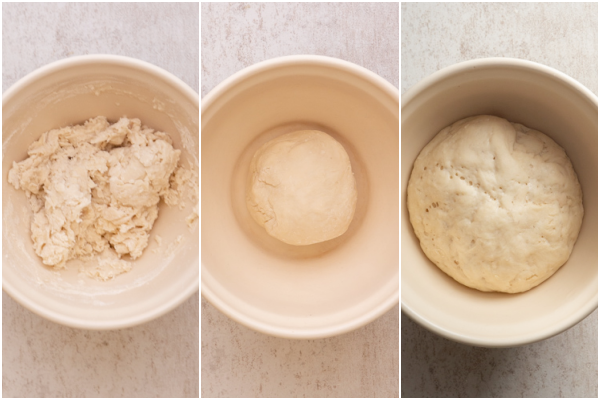
Making the first dough:
In the stand up mixer add the biga, flour, sugar and half the beaten egg. Knead with the dough hook on medium speed until almost combined then add the remaining beaten egg, knead on medium low speed (#2) for 30 minutes. Move the dough to a lightly floured flat surface and knead and fold a few times.
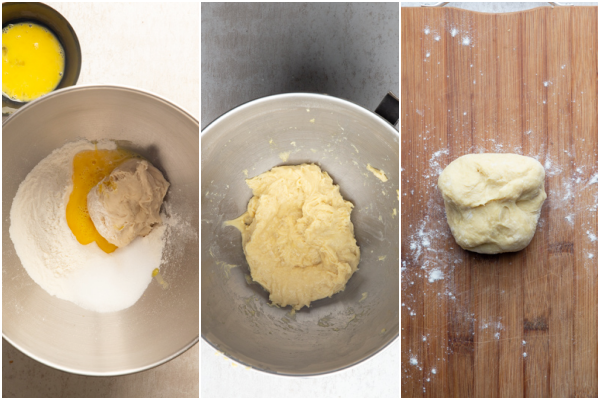
Form the dough into a ball, place in a clean bowl, cover the bowl, place it in a not too warm draft free area and let it rise 2 1/2 – 3 hours.
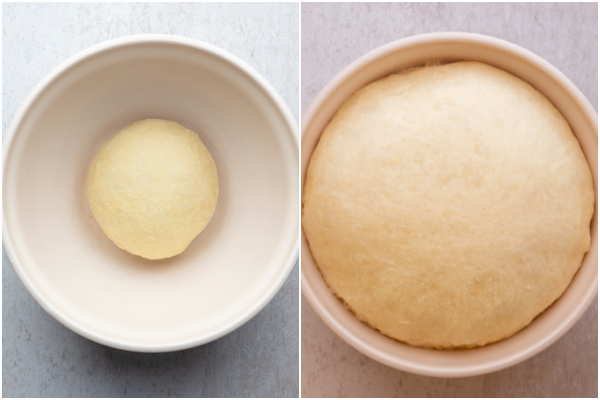
Making the 2nd dough:
In the stand up mixer add the first dough, the flour, sugar, honey, egg yolk, zest, vanilla and salt, start to knead on low medium speed (#2) for 1 minute, then add the egg one at a time, continue to knead for 30 minutes, the dough should pull away from the sides of the bowl.
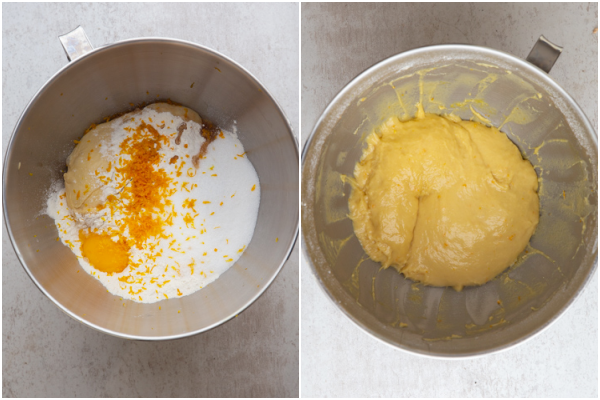
Add the butter a little at a time, kneading continuously, when all the butter has been incorporated, continue to knead for 30 minutes, the dough will be shiny and not overly sticky.
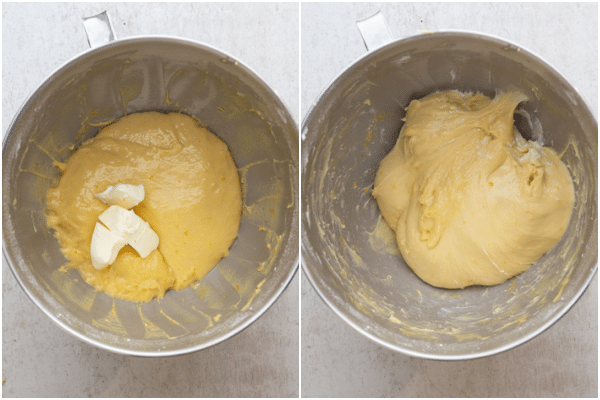
Lightly butter a your hands and a flat surface, place the dough on top and fold 4-5 times.
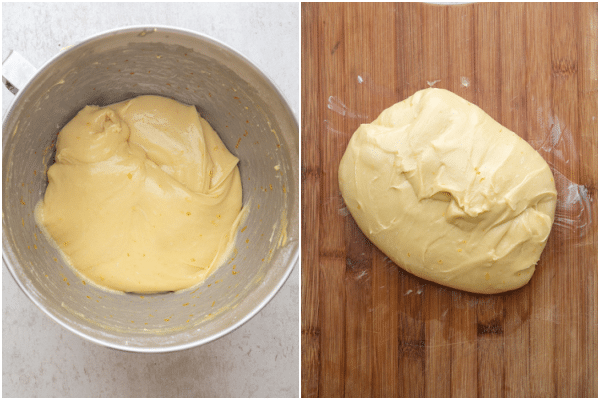
Form into a dough ball, place it seam side up in a buttered Pandoro Pan, cover and let rise in a draft free not too warm area for 4-5 hours.
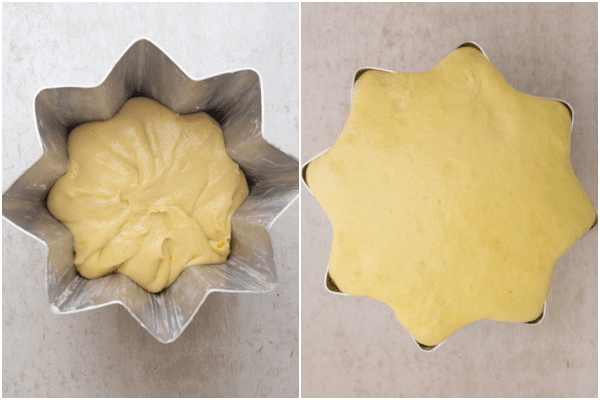
Once the dough has risen triple the volume, it should have risen over the top of the pan, bake for about 40 minutes. Let it sit 30 minutes then remove from pan and place on a wire rack to cool. Dust with powdered sugar before serving.

What is a biga and why use it?
The biga, or also known as the pre-dough, is a prepared with water, flour and yeast. A biga is left to mature for a couple of hours or sometimes even overnight, it makes the dough slower to rise because of the repeated processing and rising times, it will also guarantee a fragrant, a more digestible and better preserved product.
Why does the dough need to be folded?
Folding the dough is done to give an airiness to the dough and it helps to develop the gluten in the dough. This is a very important part in making a successful Pandoro.
Where did it originate
Pandoro is a sweet bread/cake of Veronese origin, considered the rival of the Panettone from Milan! It dates back to 1500s, which was the period of the Venetian Republic. However the first commercially produced Pandoro of Verona was on Tuesday October 14, 1884, invented by the pastry chef Domenico Melegatti.
He was inspired by an ancient Veronese tradition, which was a leavened cake covered with granulated sugar and almonds. In his recipe he eliminated the covering, added eggs and butter, which made a much softer dough and the Pandoro was invented.
The only thing missing was the shape, which was designed by a Veronese painter by the name of Angelo Dall’Oca Bianca he designed the pyramid mold with eight points that distinguishes the Pandoro.
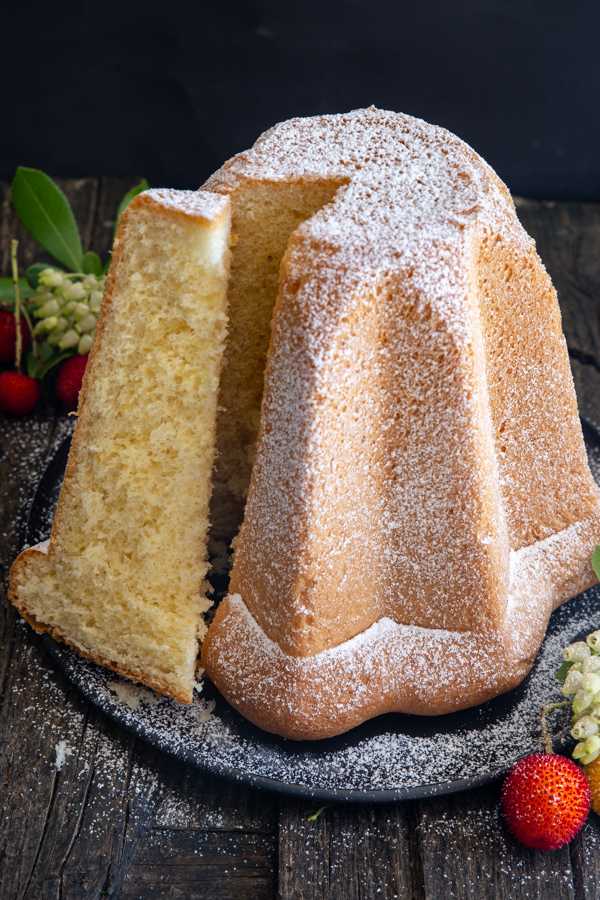
What other flavouring can I add?
The traditional Pandoro is made with vanilla but if you want to add something extra to it I would recommend lemon zest or orange zest. Our favourite was definitely orange.
Where are the cup measurements?
For this recipe I honestly think it’s very important that everything is precise, therefore the recipe is written in grams. I think once you start baking with a Kitchen Scale, you won’t be reaching for those cups! Another good tip for making the best Pandoro is to use a strong all purpose flour with at least 12-13% protein.

How to store it
Homemade Pandoro should be stored in a plastic wrap and placed in an airtight bag, it will keep for up to 6–7 days at room temperature. Freezing is not recommended.
More traditional Italian Christmas Recipes
- Italian Christmas Cookies
- Italian Angelica Cake
- Chocolate Torrone
- Amaretti Cookies
- Cream Filled Pandoro
So if you are looking for a traditional Italian recipe this Christmas I hope you give this Pandoro Italian Christmas Cake a try and let me know how it turns out. Enjoy!

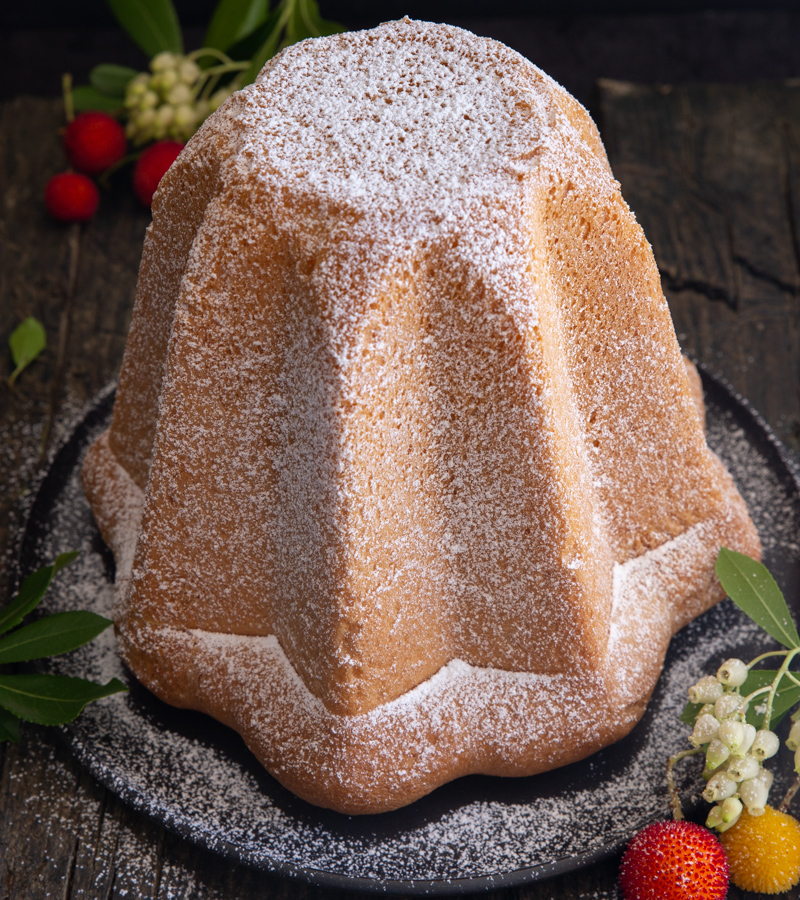
Pandoro Italian Christmas Cake
Ingredients
BIGA
- 34 grams lukewarm water (2½ tablespoons)
- 4 grams active dry yeast (1⅓ teaspoons)
- 50 grams all purpose flour (6 tablespoons)
FIRST DOUGH
- Biga (from above)
- 90 grams all purpose flour (½ cup + 3 tablespoons)
- 20 grams granulated sugar (1¾ tablespoons)
- 1 large egg (room temperature/beaten)
SECOND DOUGH
- First Dough
- 170 grams all purpose flour (1¼ cup + 1 tablespoon)
- 90 grams granulated sugar (⅓ cup + 2 tablespoons)
- 10 grams honey (½ tablespoon)
- 140 grams butter (softened) (½ cup + 2 tablespoons)
- 2 large eggs (room temperature)
- 1 large egg yolk (room temperature)
- 1 pinch salt
- 1/2 teaspoon vanilla
- zest 1 orange
Instructions
BIGGA
- In a small bowl sprinkle the yeast on top of the water, let it sit for about 5 minutes, stir it together, then add the flour and form a smooth dough. Place the dough back in the bowl and let it rise in a not too warm draft free area for about 1-2 hours or doubled in bulk.
FIRST DOUGH
- In the stand up mixer add the biga, flour, sugar and half the beaten egg. Knead with the dough hook on medium speed until almost combined about 1 minute, then add the remaining beaten egg, knead on medium low speed (#2) for 30 minutes. Move the dough to a lightly floured flat surface and knead and fold about 4 times.Form the dough into a ball, place in a clean bowl, cover the bowl, place it in a not too warm draft free area and let it rise 2 1/2 – 3 hours, until doubled in bulk.
SECOND DOUGH
- In the stand up mixer add the first dough, the flour, sugar, honey, egg yolk, zest, vanilla and salt, start to knead on low medium speed (#2) for 1 minute, then add the egg one at a time, then continue to knead for 30 minutes, the dough should pull away from the sides of the bowl.
- Butter a medium Pandoro Pan. (6×7½x7½ inches/ 15x19x19 cm) (500 grams size)
- Add the butter a little at a time, kneading continuously, when all the butter has been incorporated, continue to knead for 30 minutes, the dough will be shiny and a little sticky but not overly. Lightly butter your hands and a flat surface, place the dough on top and fold 4-5 times, form into a dough ball, place in the prepared pan seam side up, cover and let rise in a draft free not too warm area for 4-5 hours or until tripled in bulk and the dough is about 1/2 inch over the top of the pan.
- Once the dough has risen tripled in volume, it should have risen over the top of the pan, bake for about 35-45 minutes or a toothpick comes out clean. If the top is browning too much after 25 minutes then cover with foil and continue baking. Let it sit 30 minutes in the pan then remove and place on a wire rack to cool. Dust with powdered sugar before serving. Enjoy!
Notes
Nutrition
An Italian in my Kitchen is a participant in the Amazon Services LLC Associates Program, an affiliate advertising program designed to provide a means for sites to earn advertising fees by advertising and linking to Amazon.com.
Hi, I don’t have a pandoro tin can I use something else?
Hi Victoria, a 6 inch round high sided pan would also work. Take care!
Sorry for the repeat question, I just figured out how to leave a comment/question. Can the recipe be doubled? It would be great to be able to bake two of the cakes at the same time. The first cake I made was wonderful. Thank you so much.
Hi Francoise, no problem, yes the recipe can be doubled. So glade you enjoyed it. Take care!
Hi!
Can I let the dough rise overnight in the fridge for the last rise, instead of 4-5 hours at room temperature?
Hi Catalina, yes that would work, Leave it at room temperature for 45-60 minutes before baking. Let me know how it goes. Take care!
It’s in the oven now! I don’t know if my fridge was too cold or my yeast was not very alive (or maybe I did something else wrong) but the dough didn’t rise over the top of the pan (a 500 g pandoro pan). But I’m sure it will be tasty, it smells great 🙂
Hi Catalina, oh ok, maybe your pan was bigger. Let me know!
Hi Rosemary,
I would like to make the Pandora as small individual ones, how long should I bake them for?
Hi Patrizia depending on the size of them I would bake for about 20 minutes then check to see if they are done and if they need more time. Let me know how it goes. Take care!
Thank you Rosemary I will do.
Love this! Can’t wait to make it for my family again! Amazing recipe.
Hi Vanessa, thanks so much, glad you family liked it. Take care!
it was delicious, i baked not only one but two cakes at the weekend!!!:-) Your recipe is very explanatory and easy, I followed the recipe exactly as you explained and no fails:-) just taking time because of the fermentation time but too much worth to wait…. thank you so much 🙂
today I ordered a new Pandoropan, look forward to try it with that
I’d love to share photos but couldn’t find where to share it:-)
Greetings from Turkey
Yesım
Hi Yesim, thanks so much, so glad you liked it. If you have instagram you can tag “anitalianinmykitchen” and I should see the photos. Take care!
I appreciate the fine detail of the recipes and travel back in the time of the story of the Pandoro origin.
Hi Sabine, thanks so much. Happy New Year.
Hi – For the 2nd dough, do you knead for 30 minutes then add the butter bit by bit and knead another 30minutes? Or is the butter addition during the first 30 minute kneading session?
Thanks
Cara
Hi Cara, when all the butter has been added then knead for another 30 minutes. 🙂
Thanks so much!
Hi Cara, you’re welcome. Let me know how it went. Merry Christmas.
I really have to ask, do I really mix ingredients at each step with a dough hook on knead for 30 minutes? I am going to try this version this week. Bono Natale
Hi Senora, yes you do, it’s a long process but so worth it. Let me know how it goes.
Hi! I have a small question. What do you mean by a medium size pandoro pan? I have access to all sizes and I don’t know which one to buy. Do you maybe have some measurements for the pan?
Thank you very much!
Hi Irina, the size I used is 6 x 7 1/2 x 7 1/2 inches or 15x19x19cm. Hope that helps. Let me know.
Can you specify, the dimensions are misleading to me. There are three easily available sizes I see.
500, 750, 1000≥
the combine dough seems to be 210 grams of flour.
(I also suggest you link to pans (it’s a revune stream that helps us cooks.)
It seems my dough either has an issue with rising (I baked breads multiple times a week, so it’s not a yeast mistake), or my 750 pan is too big.
Hi Monty, I used a 500 gram size. HOpe that helps.
Tried this recipe today with a few tweaks after a few failed Pandoro’s last year. First one of the season and it was a hit. Grazie Mille e Buon Natale!
Hi Lavanya, thanks so much, glad you enjoyed it. Buon Natale!
Do you have equivalents for the grams….i.e. cups, tsp, tbsp?
Hi Janet, I just added the equivalents (in bracket) for the recipe. Let me know how it goes.
baked my first pandoro from youre recipe.
it was perfect.
thank you so much , lots of love from Holland
Hi Yolanda, thanks so much, so glad you enjoyed it. Holland is beautiful. Have a wonderful week.
Phenomenal recipe. So delicious and turned out beautifully. I followed the recipe exactly, except I added the butter with the other ingredients for the last dough.
I will be making this every year. Thank you!
Hi Melinda, thanks so much, so glad you enjoyed it. Happy New Year.
Hello Rosemary. Thanks for this recipe. I don’t like panettone, so that’s right up my street😊
I don’t have a mould, can a bread tin do?
Hi Dee, I think it should work, let me know how it goes.
Thank you, Rosemary. I will.